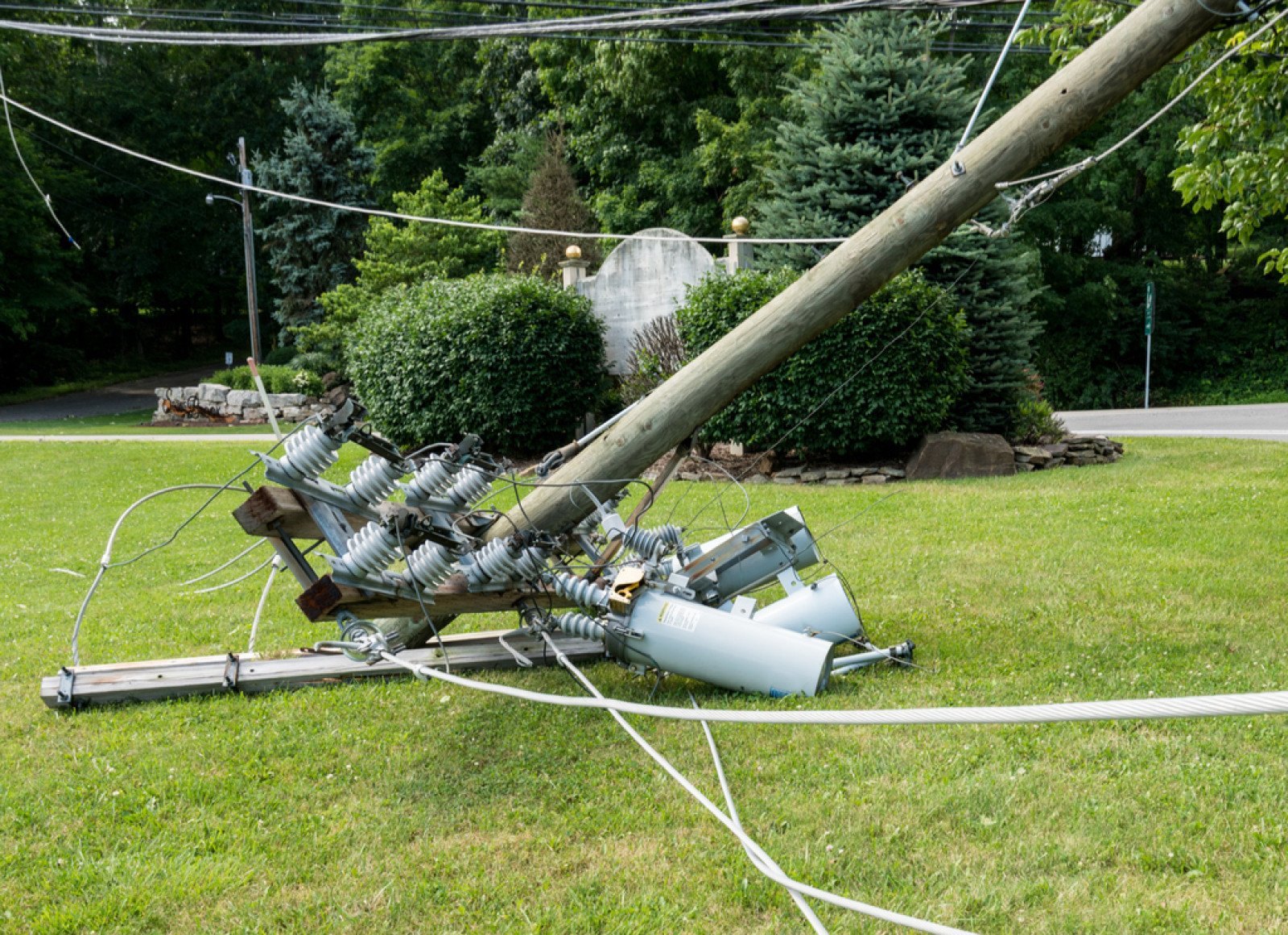
Overview
After students review what they know about safety signs and symbols, they participate in a safety demonstration about downed power lines. Remember, if it's down, it's a danger. Stay back 10 metres and dial 911.
Instructions
What you'll need
- An orange safety cone
- A 10-metre length of rope or string
- "Safety symbols" image
Introduce safety symbols
- Show students the various "Safety symbols". Ask them which ones they recognize and what they know about them. Have students share their thoughts about the symbols with a partner, then discuss them as a class.
- Introduce the "Think ahead" safety approach. Explain that when we understand what the safety hazards are, and where they can be found, we can think ahead. This means we can choose safe actions, rather than find ourselves in a situation where we or someone else could get hurt.
Downed power line demo
- Watch the video above, then take your students outside or to the gym.
- Place the orange safety cone on the ground and have students stand around it.
- Explain that you are going to pretend that the cone is a downed power line. Even if there are no sparks and the power line isn’t moving, it’s still dangerous. People can get hurt simply by standing too close to the power line because electricity can travel through the ground. Ask students to guess the safe distance from the cone.
- Explain that to be safe, people need to be at least 10 metres away from a downed power line. This is about the length of one school bus.
- Ask students to move away from the safety cone until they think they are 10 metres away. Use the length of rope or string to see if they are far enough away from the cone. If they aren’t, have them continue moving until they are a safe distance away.
- Teach your students the phrase "Down. Danger. Dial." This is a simple way to remember that downed power lines are dangerous, and to immediately dial 911 when they see one.
How to shuffle step
- Explain that if a person is within 10 metres of a downed power line, they need to shuffle their feet to get to a safe distance. To shuffle safely, your feet need to be close together and always touching so that the heel of the front foot doesn’t extend past the toes of the back foot. If you lift a foot off the ground, the electricity could move through you.
- Give students time to practice shuffling.
Review
- Have students walk around a specified area. Call out, “Downed power line,” and have them stop where they are. Place the orange safety cone somewhere in the area and have students raise their hands if they think they’re more than 10 metres away. Those that think they are within 10 metres will need to shuffle to get themselves to safety. Once everyone thinks they are at a safe distance, use the length of rope or string to check. Repeat this exercise a few times.
Modify or extend this activity
Extension
- Continue exploring electrical safety with the “Think ahead... Electrical safety” activity.
Curriculum Fit
Grade 4, 5 Physical and Health Education
Curricular competencies
Social and community health
- Identify and describe strategies for avoiding and/or responding the potentially unsafe, abusive or exploitive situations
- Describe and apply strategies that promote a safe and caring environment
Grade 6, 7 Physical and Health Education
Content
- Basic principles for responding to emergencies
Curricular competencies
Social and community health
- Identify and describe strategies for avoiding and/or responding the potentially unsafe, abusive or exploitive situations
Assessments
- Observe students during the discussion about safety symbols and during the demonstration of how to act around downed power lines to assess their ability to:
- Identify hazardous electrical situations.
- Implement strategies to be safe in hazardous situations.
Teaching Notes
Home safety
- Always “Look up and look down!” Be aware of overhead and underground power lines. The overhead wires entering houses and buildings are not insulated, only weather-protected. The “Think ahead” approach is one in which students learn to recognize potentially hazardous situations, then decide to act safely based on observations, recalling past experiences and inferring possible hazards.
Electricity awareness
- Electricity will take all paths – not just the quickest path – to reach the ground.
- Any object can be a path for high voltage electricity that is carried in power lines either above or underground, or within padmount transformers.
- Electrical contact can cause electric shock. A person who has been shocked can be unable to disconnect themselves. Electric shock can cause burns, serious internal injuries or electrocution.
- Electrocution is the term used for a death caused by electrical contact.
- Touching any object that is itself connected to live electricity can result in you becoming a path to ground. For example, if you touch a tree or ladder that becomes energized by electricity, you become a path to ground. This is called touch potential.
- Point of contact refers to the place on an object or the ground that is touching the source of electricity.
- Electricity moves from high to low concentrations and spreads away from a point of contact on the ground in concentric circles. If a person is standing with one foot on an energized part of the ground and the other foot on a less energized piece of ground, electricity will move through the person. This is called step potential.
- The best way to move away from ground that is electrically charged is to shuffle or hop. You need to get farther than 10 metres from the ground’s point of contact.
- Shuffle with your feet close together. The heel of the front foot should not pass the toes of the back foot.
- Water is an excellent conductor of electricity. Water and electricity do not mix.
- High voltage electricity can move through all types of materials including metals, wood, rubber and soil.
- Stay at least three metres away from any power line that is above ground.
- Stay back at least 10 metres from a downed power line.
- Call 911 if you see a downed or damaged power line.
- Remember these three words: Down. Danger. Dial.
Storms and power outages
- Storms and accidents can cause power lines to fall to the ground. Even if there are no sparks or sounds, downed power lines may still be energized. Never go near or touch a fallen power line. Stay back at least 10 metres from any downed line as the ground itself could be energized. Call 911 immediately upon seeing a downed power line.
- If your car hits a power pole or a padmount transformer, or if a power line falls on your car during a storm or accident:
- If you can safely drive out from under the power line or away from the source of electricity, do so. Travel the length of a bus, about 10 metres, before stopping.
- If you can’t drive the vehicle – if you’re injured, if the vehicle is inoperable, or there are obstacles in your way – stay where you are until help arrives. Unless there’s a secondary emergency, such as a fire in the vehicle, you’re safer in the vehicle.
- If you absolutely must get out of the vehicle, perhaps because of a fire, remember you must not touch the vehicle and the ground at the same time with any part of your body or clothing. Be sure to follow these steps:
- Remove any loose-fitting clothing like jackets or scarves.
- Use the handle to open the door of your vehicle, but don’t touch the door itself.
- Stand at the opening of your door with your elbows tucked into your stomach and your hands held close to your chest.
- Jump out and away from the vehicle. Land with your feet together. Don’t stumble.
- Calmly shuffle with your feet together. Keep your feet touching as you shuffle. The heel of one foot should still be touching the toe of the other when you start moving the other leg.
- Keep shuffling until you are at least 10 metres away.
- Call 911 for help.
- Prepare for a power outage. Develop a preparedness plan and share it with your family.
- Make a list of local emergency contact numbers. Purchase or prepare an emergency kit and store it in an easy-to-find location.
- Home generators can be useful during a power outage, but they can also be dangerous if they are not used properly. Never use a portable generator indoors, including inside a garage or other enclosed or partially enclosed area, because poisonous carbon monoxide gas can build up.
- Never plug a portable generator into a regular household electrical outlet. This can cause energy to flow back into the power lines which can be hazardous to your neighbours and BC Hydro workers.
Recreational areas and dam sites
- Never stand, swim, fish, anchor or tie your boat immediately downstream of a dam. Water levels and flows can change rapidly and take you by surprise, swamping your boat or catching you in an undertow.
- Stay clear of generating facilities including dams, powerhouses and all electrical equipment.
- Respect fenced and gated areas, and observe all safety signs.
- Stay on designated trails and within marked observation areas.
- Stay outside of safety booms and buoys, and away from all dam structures.
- Be alert for audible warnings like sirens and visual warnings like strobe lights.
- Be alert for changes in water levels.
- Stay off hydroelectric dams or station structures.
- You don’t have to touch a power line to be shocked or electrocuted; if you come within three metres of power lines, the energy can arc towards you and use you as a path to the ground.
- Stay back at least 3 metres from any power line.
- Always call BC One Call at 1-800-474-6886 before digging to avoid underground electricity, gas or service lines.
- When disconnecting an appliance, pull the plug, not the cord.
- Don’t overload circuits. This can cause short circuits and possibly a fire. If multiple connections are required, use a properly rated power bar.
- Never use cords or plugs that show any wear or damage. They can cause shocks or fires.
- Never prune or cut down a tree near a power line. Call BC Hydro first (1-800-BCHYDRO) or contact a qualified arborist. If there is a tree touching a line, call BC Hydro to report it.
- Never climb trees that grow near power lines. Electricity can move through the tree or jump towards you if you are within 3 metres of the power line.
- Never climb or play around padmount transformers (the metal boxes with BC Hydro logos that are situated around neighbourhoods and anchored to the ground).
- Keep kites, balloons, remote-controlled airplanes, drones and other such objects away from overhead power lines.
- Do not use a two-pronged extension cord outdoors.
- Never touch someone who is being shocked, no matter how badly you want to help, because you can also be shocked. Call 911 and wait until BC Hydro can isolate and turn off the power.
Water and electricity
- Keep all electrical cords away from water and sources of heat.
- Never use electrical tools or appliances near water, and never store water or liquids near appliances.
- Never use an electric lawn mower when it is raining or on wet grass.
- Keep radios and appliances that are plugged in away from swimming pools and wet surfaces.








